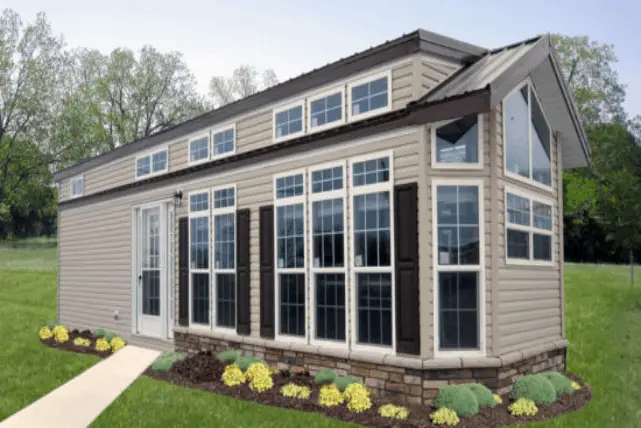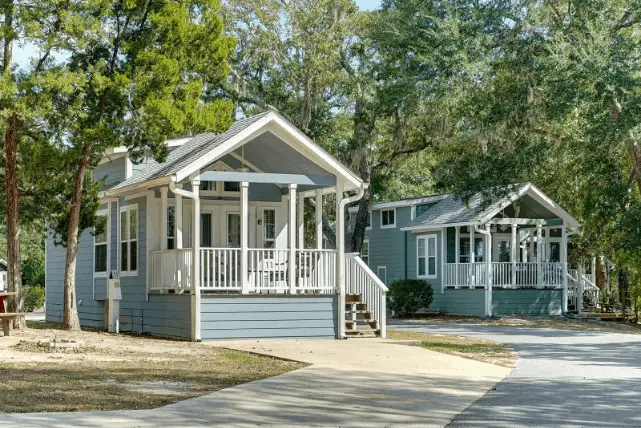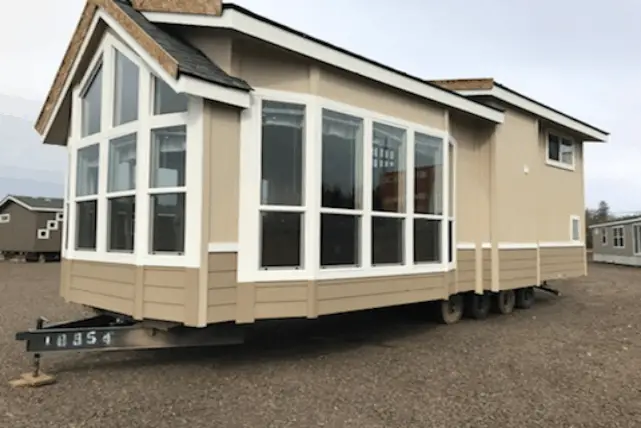Let’s see, we have site-built homes, modular homes, manufactured homes, tiny homes, park model homes, RVs, travel trailers, tents, etc. There has never been a wider choice of dwelling units for people than there are today. But what exactly is a “park-model home” and how does it differ from other housing types?
Table of Contents
The Short Answer
So, a park-model home is probably most like a tiny house. It usually:
- Has 400sf of floor space or less
- Is 10’ to 12’ wide
- Is built on a single trailer chassis
- Is set up in an RV or mobile home park
- Has its axles and wheels removed after set up
- Is skirted like a mobile home
- Is not meant to be mobile
- Has a living room area, kitchen, a bathroom, and one bedroom.
- Cannot be set up on private land in many locales.
So why do so many people seem to hate on park models? Let’s explore that a bit further.
So Why Choose A Park Model?
Having been in real estate for 16 years, if I’ve learned anything at all, its that there is a buyer for every type of home. Every type of home is for certain people, and not for others.
Why would someone choose a park model home over let’s say a tiny house or a manufactured home? Especially when all three have variations that can be purchased for around the same amount?

Some of the reasons for a park model might be:
- Built to exacting standards in a factory.
- Wider than a tiny house, so it doesn’t feel as small.
- Often the perfect size for a vacation or seasonal home.
- Can be set up to be fairly permanent with porches and add-ons.
- Can generally be highly customized through available options.
- Doesn’t cost nearly as much to set up as a larger manufactured home.
- Designed for placement in RV parks, campgrounds or locations where smaller trailers are allowed.
But What About The Building Standards
Site-built homes must be built to local building codes. Manufactured homes must be built to HUD construction standards. But, park model homes, which look much like a smaller single-wide home, are actually classified as Recreational Vehicles (RV).
Like other recreational vehicles, park models are regulated by the RV Industry Association (RVIA) and are built to American National Standards Institute (ANSI) standards.
Quoting directly from the RVIA website:
“On July 1, 2012, RVIA created a new membership category for manufacturers of park model RVs (PMRVs). A park model RV (also known as a recreational park trailer) is a trailer-type RV that is designed to provide temporary accommodation for recreation, camping or seasonal use. PMRVs are built on a single chassis, mounted on wheels and have a gross trailer area not exceeding 400 square feet in the set -up mode. They are certified by their manufacturers as complying with the ANSI A119.5 standard for recreational park trailers.”
To look further into what ANSI standards consist of, follow this link to the “Association And ANSI Standards”.
Park models, by definition, do not exceed 400 square feet of floor space. The same goes for tiny homes. Both of these structures may have lofts that are not included in the square footage, but the head clearance for the loft area usually does not exceed 60 inches, so the loft is mainly used for sleeping or hanging out.
The difference is that most tiny homes are about 8’ 3” wide for easy transportation to different locations. They are meant to be mobile. Park models are usually 10” to 12” wide and require special permits to be moved to a new location; if they’re ever moved. The difference in width may not seem like a lot, but 12 feet is almost 47% wider than 8 feet 3 inches.
Since park models are built on a single trailer chassis, they can be quickly set up at a park. Most park models after set-up have their wheels and axles removed and are skirted like a larger manufactured home.
Park Model History
Way back in the 1950s, there was called Pacemaker Trailer Company out of Elkhart, Indiana. They introduced the novel concept of a bi-level trailer. What it was designed to do was give the greatest amount of possible livability while still using a minimum amount of floor space. This made it far easier to “take your home with you” during your travels.

The modern park model is a loose take on those old homes from the 1950s. Today’s park model is smaller than those bi-level trailer homes of the 1950s. But, it is as functional in every way, as well as being more livable.
Remember that by definition, a park model is classified as a recreational vehicle. Yet, its designed function is for something a longer-term living or even permanent placement, in an RV or mobile home park.
To make it more livable than a typical RV, it is usually designed with distinct living areas. A living room, Kitchenette, bathroom, and bedroom. Because park models are wider than an RV, they also give a much more comfortable level of living. Some modern park models also have a loft area, which can be used for additional sleeping or just hanging out. The lofts generally have ceiling heights of 60 inches or less.
Many retired people use these homes. There are many popular communities in Florida, Texas, Arizona and other warm climates where people like to come during the winter months to escape the cold weather at home. Park models have become very popular in filling the living needs of people while they are away from home. They offer the functionality and aesthetics for longer-term living while being affordable and efficient.
Park model square footage is often expanded by screened-in porches, verandas or lanais that become part of the living space of the home. Because these homes are typically used during the winter months, these outdoor rooms offer great comfort and expansion of the small floor space of the home.
So Why The Bad Wrap For Park Models?
I often wonder why park models tend to get such a bad wrap? I often think that it is because a new park model home typically costs more than a manufactured home that is recent, but a little older. The manufactured home offers far more living space, while the initial cost can be lower.
While this argument may be true, the operating cost for a larger manufactured home will be more. The park rent is often greater for the larger home as well as the utilities.
To me, the greatest difference is in the permanence of the homes. Although park models are often set up to be permanent, they are easier and far less expensive to move and set up at a new location than a larger manufactured home would be. This single fact makes a park model more reasonable for a person that might not want to keep the home in the same location year after year.
Tiny Homes Are All The Rage, Why A Park Model?
Tiny homes in recent years certainly have the limelight. There are several reality TV shows dedicated to tiny homes. A new tiny home and a park model will both cost today anywhere from $50,000 to about $80,000 to purchase. They are also about the same size. Tiny homes can be very attractive, so why not one of those?
The difference really comes down to livability and mobility. Tiny homes are almost always narrower than a park model. Tiny homes are designed and built to be easily transportable. For ease of transport, they are usually about 8 feet 3 inches wide. They can be usually be moved without the red tape involved in moving a park model home that is 10 to 12 feet wide.
That difference in width though is what generally makes a park model far more livable than a tiny home. Every added foot, or even inches, of width, make a home feel far more spacious and livable. A wider park model home can often give the feeling of a much larger structure than can a tiny home because of that difference in width. Simply put, tiny homes can just feel too narrow and too constricting for the needs of many people.
For many, park models are a lot like Goldilocks while visiting the home of the 3 bears. Everything the mama bear had felt just right. Not too big, not too small, but just right. When looking at a larger manufactured home, a tiny home or a park model, many people find the park model to be “just right”!

Related Questions
“How Much Does It Cost To Move A Mobile Home?”
“Mobile Home”! Just the name alone sounds like you should be able to easily hitch it up and haul it off to a new location. This was easier back in the early days when the homes were much smaller. Today, the process is a massive undertaking and expensive. It is much more involved than it used to be back in the day. So how much does it cost? Let’s take a look…
- Singlewide – $1,000 to $8,000
- Doublewide – $2,000 to $16,000
- Triplewide – $3,000 to $24,000
At first glance, you may wonder why there is such a wide variation in pricing. The prices depend largely on how much you do yourself and how much you pay others to have done. The lower end is just the prices for moving the home (maybe up to 60 miles or so). There are far more costs involved, so let’s dive in and take a look at what you can realistically expect to spend if you really want to move a manufactured home.
“Can You Be Evicted From A Mobile Home Park?”
Eviction sucks! Unfortunately, it happens though. Since most people living in mobile home parks own their homes, you’d think they don’t have to worry about eviction. Well, the leased lot creates a problem with that. This article assumes you own your home, but not your lot.
If you’re concerned about facing eviction, my goal is to share with you some valuable tips that can help you work through it, or even avoid it.
Yes, as a mobile homeowner, you can be evicted from the park your home is located in. Parks have the ability to evict you if you’re behind on lot rent, or if you’re in breach of your lease terms. Here are some tips that will help you.

